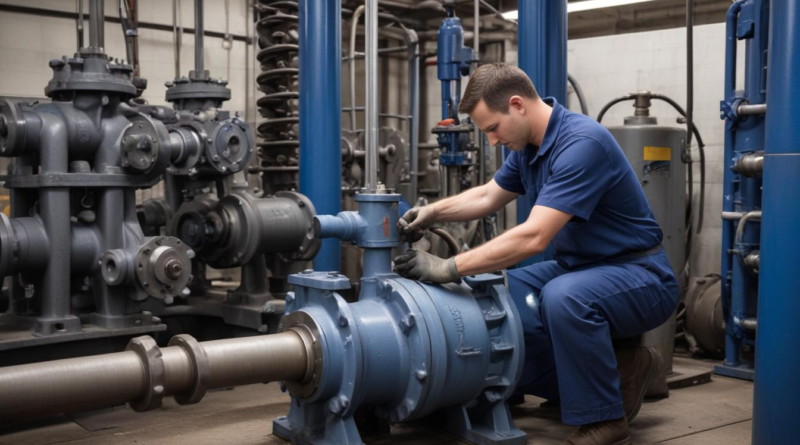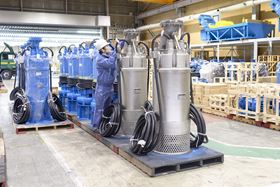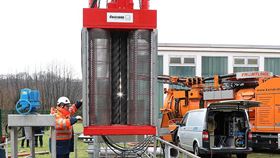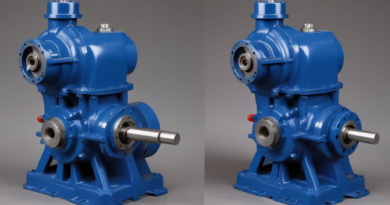how to perform pump maintenance during shutdowns
Ensuring safety during pump maintenance is paramount to prevent accidents and ensure a smooth shutdown process. Adhering to stringent safety protocols minimizes risks to personnel and equipment. Key safety precautions include:
- Lockout/Tagout (LOTO) Procedures: Before commencing any maintenance activities, ensure that all energy sources are properly isolated and secured. This includes shutting down the pump, de-energizing electrical circuits, and applying lockout/tagout devices to prevent accidental re-energization.
- Personal Protective Equipment (PPE): All maintenance personnel must wear appropriate PPE, such as safety helmets, gloves, eye protection, and protective footwear. Depending on the specific tasks, additional gear like hearing protection or respiratory masks may be necessary.
- Hazard Identification and Assessment: Conduct a thorough assessment to identify potential hazards associated with the maintenance tasks. This includes chemical exposures, moving parts, and electrical risks. Implement measures to mitigate identified hazards.
- Training and Communication: Ensure that all team members are adequately trained in pump maintenance procedures and safety protocols. Maintain clear communication channels to coordinate activities and address any concerns promptly.
- Use of Proper Tools and Equipment: Utilize tools and equipment that are in good condition and suitable for the tasks at hand. Regularly inspect tools for signs of wear or damage before use.
- Emergency Procedures: Establish and communicate emergency response plans in case of accidents or unexpected incidents. Ensure that first aid kits and emergency equipment are readily accessible.
- Environmental Considerations: Be mindful of environmental regulations and practices. Prevent spills and manage waste materials responsibly to minimize environmental impact during maintenance activities.
Implementing these safety precautions as part of the pump maintenance procedures during shutdowns ensures a safe working environment and enhances the efficiency of the maintenance process.
disassembly procedures
Properly executing the disassembly process is critical to ensure effective pump maintenance during shutdowns. Following a systematic approach minimizes the risk of damage to components and enhances the efficiency of subsequent maintenance tasks. The following procedures outline the essential steps for disassembling a pump:
- Document Existing Setup: Before beginning disassembly, thoroughly document the current configuration of the pump. This includes taking photographs and making detailed notes of component placements and connections. Proper documentation aids in accurate reassembly.
- Drain Fluids: Ensure that all liquids within the pump system are completely drained. This includes residual process fluids and any lubricants present. Use appropriate containers to collect and store fluids for safe disposal or recycling in accordance with environmental regulations.
- Disconnect Electrical and Mechanical Connections:
- Electrical: Safely disconnect all electrical wiring and components. Label each wire to ensure correct reconnection during reassembly.
- Mechanical: Detach any mechanical linkages, such as coupling assemblies and drive belts. Use appropriate tools to avoid damaging mating surfaces.
- Remove External Components: Carefully detach external accessories attached to the pump, such as seals, gaskets, and auxiliary devices. Inspect these components for wear and damage, replacing them if necessary.
- Disassemble Pump Casing:
- Unscrew and remove mounting bolts securing the pump casing. Keep track of bolt sizes and locations using a labeled container or a magnetic tray.
- Gently separate the pump casing halves, taking care to avoid applying excessive force that could cause deformation.
- Extract Internal Components: Once the casing is open, carefully remove internal parts such as the impeller, shaft, bearings, and seals. Handle all components with care to prevent damage. Use appropriate lifting tools if components are heavy or cumbersome.
- Inspect Components: After removal, perform a preliminary inspection of each component. Look for signs of wear, corrosion, or damage that may require further attention during the pump maintenance process.
- Organize and Label Parts: As components are removed, organize and label them to facilitate easy identification during reassembly. Using labeled containers and clearly marking parts helps prevent confusion and ensures that each piece is returned to its correct position.
- Store Components Securely: Place disassembled parts in a clean, dry environment to protect them from contaminants and damage. Utilize shelving or designated storage areas to keep components organized and accessible for the next maintenance steps.
| Step | Description | Tools Required |
|---|---|---|
| 1 | Document existing pump setup with photos and notes. | Camera, notepad |
| 2 | Drain all fluids from the pump system. | Drain pans, appropriate containers |
| 3 | Disconnect electrical wiring and mechanical linkages. | Wrench set, wire labels |
| 4 | Remove external components such as seals and gaskets. | Screwdrivers, gasket scrapers |
| 5 | Disassemble pump casing by removing mounting bolts. | Socket set, torque wrench |
| 6 | Extract internal components like impellers and bearings. | Pump pullers, lifting tools |
| 7 | Perform a preliminary inspection of each component. | Inspection mirror, flashlight |
| 8 | Organize and label all removed parts for easy identification. | Label maker, containers |
| 9 | Store components securely in a clean, dry area. | Shelving units, storage bins |
Following these disassembly procedures ensures a structured and efficient approach to pump maintenance during shutdowns. Proper execution of each step not only safeguards equipment integrity but also sets the foundation for a successful reassembly and testing phase.
cleaning and inspection
After the pump components have been carefully disassembled and organized, the next critical step involves meticulous cleaning and thorough inspection. Proper execution of these tasks not only extends the lifespan of the pump but also ensures optimal performance during operations. The following procedures outline the essential steps for effective cleaning and inspection:
Cleaning Procedures
1. Initial Debris Removal:
– Use brushes and compressed air to remove loose debris and contaminants from all disassembled parts. Pay special attention to hard-to-reach areas where dirt and residue may accumulate.
2. Cleaning with Solvents:
– Submerge metal components such as impellers, shafts, and casings in appropriate solvents to dissolve grease, oil, and other stubborn contaminants. Ensure that the chosen solvent is compatible with the material of the pump parts.
3. Ultrasonic Cleaning:
– For intricate components, consider using ultrasonic cleaning machines. These devices use high-frequency sound waves to create cavitation bubbles that effectively remove contaminants without causing damage.
4. Rinsing and Drying:
– After solvent cleaning, rinse all parts thoroughly with clean water to remove any residual solvent. Dry the components completely using clean cloths or air dryers to prevent corrosion and prepare them for inspection.
5. Surface Treatment:
– Inspect all cleaned surfaces for any signs of corrosion or pitting. Apply protective coatings or lubricants as necessary to safeguard against future wear and environmental factors.
Inspection Procedures
1. Visual Inspection:
– Examine each component for visible signs of wear, cracks, corrosion, or deformation. Utilize inspection mirrors and flashlights to enhance visibility, especially in concealed areas.
2. Dimensional Measurements:
– Use precision measuring tools such as calipers, micrometers, and dial indicators to verify that all components meet the manufacturer’s specifications. This includes checking the dimensions of impellers, shafts, and bearing housings.
3. Surface Integrity Checks:
– Inspect the surface finish of all parts to ensure there are no imperfections that could lead to operational failures. Look for signs of erosion, excessive roughness, or other surface defects.
4. Leak Tests:
– For components such as seals and gaskets, perform leak tests to ensure they can maintain proper sealing under operating conditions. Replace any parts that fail to meet the required standards.
5. Material Analysis:
– In cases where corrosion or material degradation is suspected, conduct material analysis using techniques like spectroscopy or hardness testing to determine the extent of deterioration and appropriate corrective actions.
Documentation and Reporting
Maintaining detailed records of the cleaning and inspection processes is vital for ongoing maintenance and future reference. The following table outlines the key aspects to document:
| Aspect | Description | Tools/Methods |
|---|---|---|
| Visual Inspection Findings | Document any visible defects such as cracks, corrosion, or deformation. | Inspection mirrors, flashlights, photography |
| Dimensional Measurements | Record measurements of critical dimensions and compare them to specifications. | Calipers, micrometers, dial indicators |
| Surface Integrity | Note the condition of surface finishes and any imperfections. | Surface gauges, visual assessment |
| Leak Test Results | Log the outcomes of leak tests on seals and gaskets. | Pressure gauges, leak detection fluids |
| Material Analysis | Detail findings from material integrity tests. | Spectroscopy equipment, hardness testers |
| Cleaning Methods Used | Describe the cleaning techniques and solvents employed. | Ultrasonic cleaners, solvent types |
Best Practices
– Use of Appropriate Cleaning Agents: Select cleaning agents that are suitable for the specific materials and contaminants present in the pump components to avoid damage during the cleaning process.
– Scheduled Inspections: Implement regular inspection schedules to detect potential issues early and address them before they escalate, minimizing downtime during future shutdowns.
– Training and Expertise: Ensure that maintenance personnel are adequately trained in cleaning and inspection techniques to maintain high standards of quality and safety.
By adhering to these comprehensive cleaning and inspection procedures, maintenance teams can effectively prepare pump components for the subsequent stages of maintenance. This meticulous approach ensures that all parts are in optimal condition, thereby enhancing the reliability and performance of the pump during and after the shutdown period.
part replacement and repairs
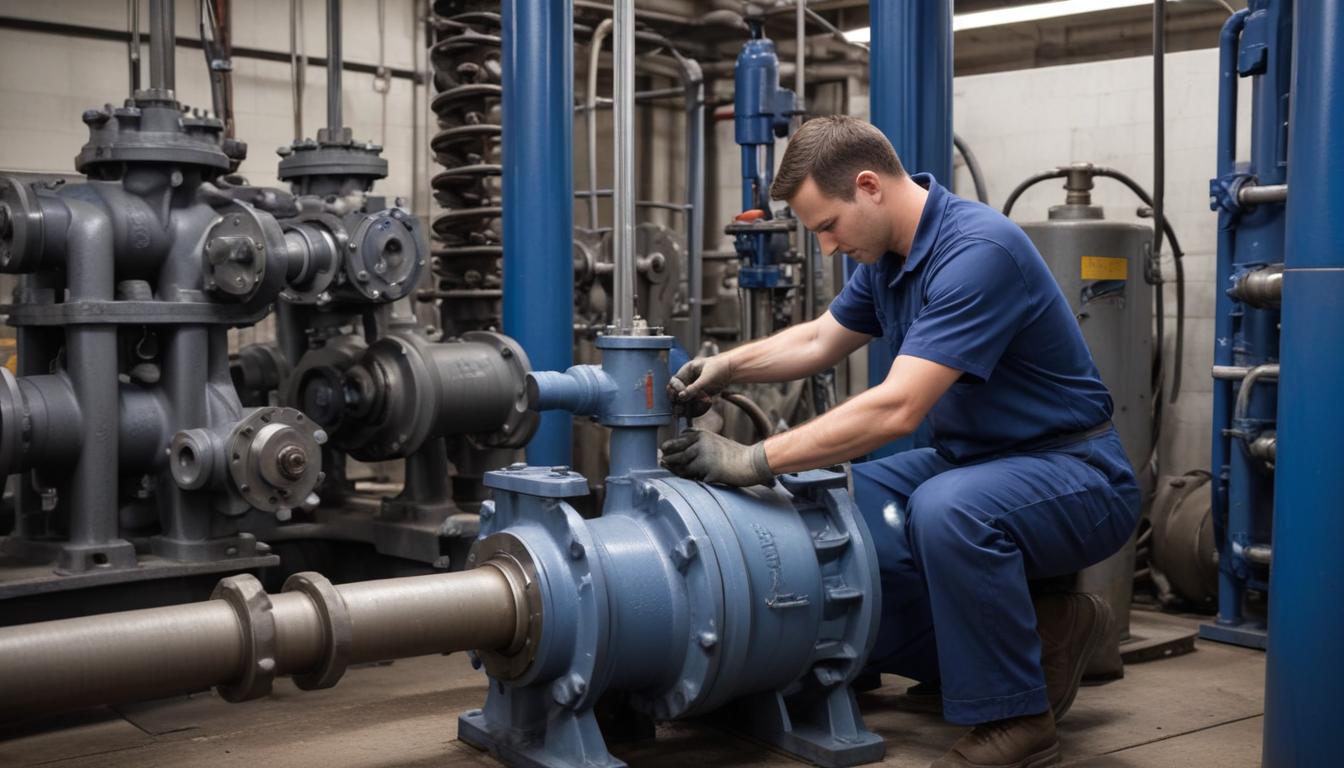 Part replacement and repairs are critical components of effective pump maintenance during shutdowns. Addressing worn or damaged parts ensures the pump operates efficiently and minimizes the risk of future failures. The following procedures outline the essential steps for identifying, selecting, and replacing pump components, as well as performing necessary repairs:
Part replacement and repairs are critical components of effective pump maintenance during shutdowns. Addressing worn or damaged parts ensures the pump operates efficiently and minimizes the risk of future failures. The following procedures outline the essential steps for identifying, selecting, and replacing pump components, as well as performing necessary repairs:
- Identify Worn or Damaged Parts:
- Review inspection reports and visual assessments to pinpoint components that require replacement or repair.
- Common parts needing attention include impellers, seals, bearings, shafts, and gaskets.
- Prioritize parts based on their criticality to pump operation and the severity of wear or damage.
- Select Appropriate Replacement Parts:
- Consult the pump manufacturer’s specifications to ensure compatibility and optimal performance.
- Opt for OEM (Original Equipment Manufacturer) parts when possible to guarantee quality and fit.
- Consider the material and design of replacement parts to match the operating conditions and fluid characteristics.
- Prepare Replacement Parts:
- Inspect new parts for any defects or damage prior to installation.
- Ensure that all necessary tools and equipment are available and in good condition.
- Organize replacement parts in a systematic manner to facilitate efficient installation.
- Remove Faulty Components:
- Carefully detach the identified parts using appropriate tools, taking care not to damage surrounding components.
- Clean the mounting surfaces to remove debris, old sealant, or residue that could affect the installation of new parts.
- Dispose of worn or damaged parts in accordance with environmental and safety regulations.
- Install Replacement Parts:
- Apply suitable lubricants or sealants as recommended by the manufacturer to ensure proper seating and functionality.
- Mount the new components carefully, adhering to torque specifications and installation procedures to prevent over-tightening or misalignment.
- Reassemble any disassembled sections, ensuring all connections are secure and correctly positioned.
- Perform Repairs on Reusable Parts:
- Assess if certain parts can be repaired instead of replaced, such as realigning shafts or refurbishing bearings.
- Use precision tools and follow manufacturer guidelines to carry out repairs, ensuring the integrity and performance of the component.
- Test repaired parts for functionality and durability before reinstallation.
- Quality Assurance:
- Conduct thorough inspections of replaced and repaired parts to verify correct installation and functionality.
- Ensure that all fasteners are tightened to specified torque values and that there are no loose connections.
- Document all replacements and repairs, including part numbers, installation dates, and any observations during the process.
| Component | Signs of Wear/Damage | Replacement Tools |
|---|---|---|
| Impeller | Cracks, erosion, imbalance | Impact driver, sealant |
| Seals and Gaskets | Leaks, hardening, deformation | Gasket scraper, torque wrench |
| Bearings | Unusual noises, excessive vibration | Bearing puller, lubricant |
| Shaft | Bending, corrosion, wear | Shaft alignment tool, grinder |
| Couplings | Misalignment, wear, cracks | Wrenches, alignment tools |
Best Practices
- Maintain Detailed Records: Keep comprehensive documentation of all replacements and repairs, including part specifications, installation dates, and maintenance personnel involved. This aids in future maintenance planning and provides a historical record for troubleshooting.
- Use Quality Tools and Equipment: Ensure that all tools used for part replacement and repairs are of high quality and properly calibrated. This helps prevent damage to components and ensures precise installations.
- Adhere to Manufacturer Guidelines: Follow the pump manufacturer’s instructions and recommendations for part replacements and repairs. This ensures that maintenance procedures align with the pump’s design and operational requirements.
- Implement a Standardized Workflow: Develop and follow a consistent workflow for part replacement and repairs. This standardization enhances efficiency, reduces the likelihood of errors, and ensures that all necessary steps are completed systematically.
- Train Maintenance Personnel: Ensure that all team members are adequately trained in diagnosing issues, handling parts, and performing replacements and repairs. Skilled personnel contribute to higher quality maintenance outcomes and safer operations.
- Inspect Repaired Parts: After performing repairs, thoroughly inspect the components to ensure that the repairs meet the required standards and that the parts will function correctly within the pump system.
By following these comprehensive procedures for part replacement and repairs, maintenance teams can effectively address issues identified during inspections, thereby enhancing the reliability and longevity of the pump. This meticulous approach to pump maintenance during shutdowns not only ensures optimal performance but also reduces the likelihood of unscheduled downtimes and extends the overall lifespan of the equipment.
reassembly and testing
Reassembling the pump following maintenance is a critical phase that requires precision and adherence to established procedures to ensure the equipment functions correctly upon restart. The following steps outline the essential procedures for reassembly and subsequent testing:
- Verify Cleanliness:
- Ensure all components are thoroughly cleaned and free from debris or contaminants. Any remaining residue can impair pump performance and lead to premature wear.
- Double-check that all parts are dry and properly treated with necessary lubricants or protective coatings.
- Begin Reassembly:
- Start by reassembling internal components such as the impeller, shaft, and bearings. Follow the reverse order of disassembly to ensure correct placement.
- Install new seals and gaskets, ensuring they are positioned correctly to prevent leaks. Use sealant where specified by the manufacturer.
- Reattach Pump Casing:
- Carefully align and place the pump casing halves back together, ensuring that all mating surfaces are properly seated.
- Insert and tighten mounting bolts in a crisscross pattern to evenly distribute pressure and prevent distortion. Refer to the torque specifications provided by the manufacturer.
- Reconnect Electrical and Mechanical Components:
- Reattach all electrical wiring, ensuring that each wire is connected to the correct terminal as per the documentation. Secure connections with appropriate tools.
- Reconnect mechanical linkages, such as coupling assemblies and drive belts. Verify that all connections are secure and aligned to prevent undue stress during operation.
- Install External Components:
- Reattach any external accessories, including auxiliary devices, seals, and gaskets. Ensure that all components are properly aligned and secured.
- Check that all fasteners are tightened to the manufacturer’s recommended torque settings to avoid leaks or mechanical failures.
- Final Inspection:
- Conduct a thorough visual inspection of the entire assembly to ensure that all components are correctly installed and that there are no visible signs of misalignment or improper installation.
- Verify that all tools and materials used during maintenance are removed from the work area to prevent contamination or damage during operation.
- Conduct Initial Testing:
- Power up the pump system and perform a preliminary test without load to ensure that all electrical connections are functioning correctly and that there are no immediate issues such as unusual noises or vibrations.
- Gradually introduce load conditions while continuously monitoring the pump’s performance, observing for any signs of leaks, vibration abnormalities, or temperature irregularities.
- Monitor Performance:
- Use diagnostic tools to monitor key performance indicators such as flow rate, pressure, and power consumption. Compare these metrics against baseline values to assess the pump’s operational status.
- Identify and address any discrepancies promptly to ensure that the pump operates within the desired parameters.
- Documentation and Reporting:
- Record all reassembly and testing activities, including any adjustments made during the testing phase. This documentation is essential for future maintenance planning and troubleshooting.
- Update maintenance logs with details of replaced parts, performed repairs, and any observations noted during testing.
| Step | Description | Tools/Equipment |
|---|---|---|
| 1 | Ensure all components are clean and dry before reassembly. | Cleaning supplies, dry cloths |
| 2 | Reassemble internal components in reverse order of disassembly. | Wrenches, screwdrivers |
| 3 | Reconnect the pump casing and tighten mounting bolts to specifications. | Torque wrench, socket set |
| 4 | Reconnect electrical wiring and mechanical linkages, ensuring correct placement. | Insulation tape, wire labels, coupling tools |
| 5 | Reattach external components such as seals and gaskets. | Screwdrivers, gasket installer |
| 6 | Conduct a final visual inspection of the assembled pump. | Inspection mirror, flashlight |
| 7 | Perform initial testing without load to check for immediate issues. | Multimeter, vibration analyzer |
| 8 | Introduce load gradually while monitoring performance metrics. | Flow meters, pressure gauges |
| 9 | Record all activities and update maintenance logs accordingly. | Maintenance software, logbooks |
Best Practices
- Adhere to Manufacturer Specifications: Always follow the pump manufacturer’s guidelines for reassembly and torque settings to ensure proper functionality and longevity.
- Ensure Proper Alignment: Misalignment of mechanical components can lead to increased wear and potential failure. Use alignment tools to verify that all parts are correctly positioned.
- Test in Stages: Gradually introduce operational loads to detect issues early. This staged approach allows for immediate corrective actions without causing significant damage.
- Use Diagnostic Tools: Utilize advanced diagnostic equipment to monitor pump performance accurately. Tools such as vibration analyzers and flow meters provide valuable data for assessing pump health.
- Maintain Clear Documentation: Keeping detailed records of the reassembly and testing processes facilitates future maintenance activities and aids in troubleshooting any issues that arise post-maintenance.
- Train Personnel: Ensure that all maintenance team members are trained in reassembly and testing procedures. Skilled personnel are essential for executing tasks accurately and efficiently.
By meticulously following these reassembly and testing procedures, maintenance teams can ensure that the pump is correctly assembled and operates efficiently after shutdowns. This thorough approach not only enhances the reliability and performance of the pump but also minimizes the risk of operational disruptions and extends the equipment’s service life.

